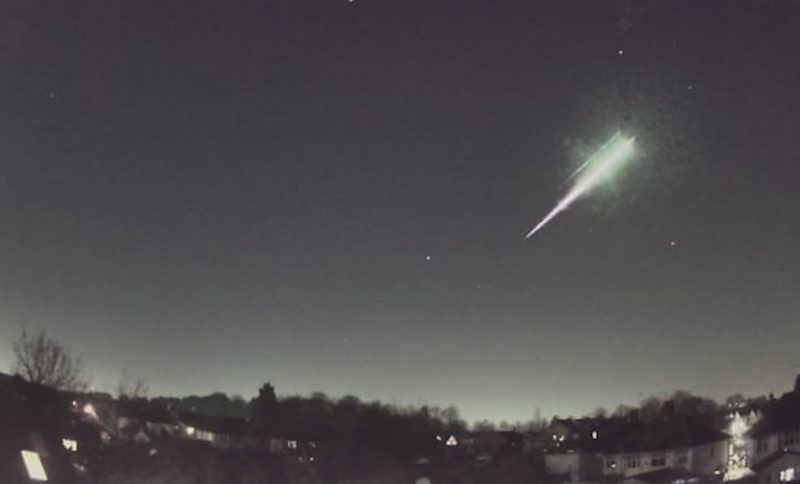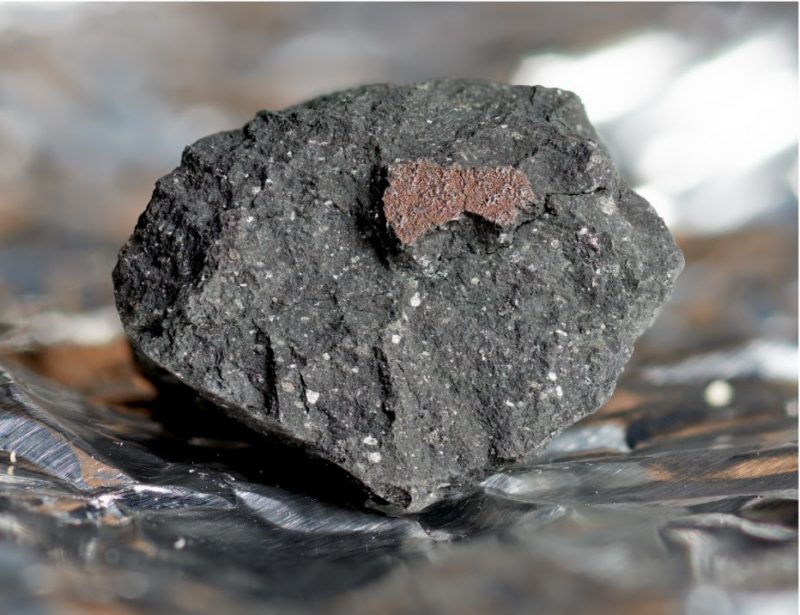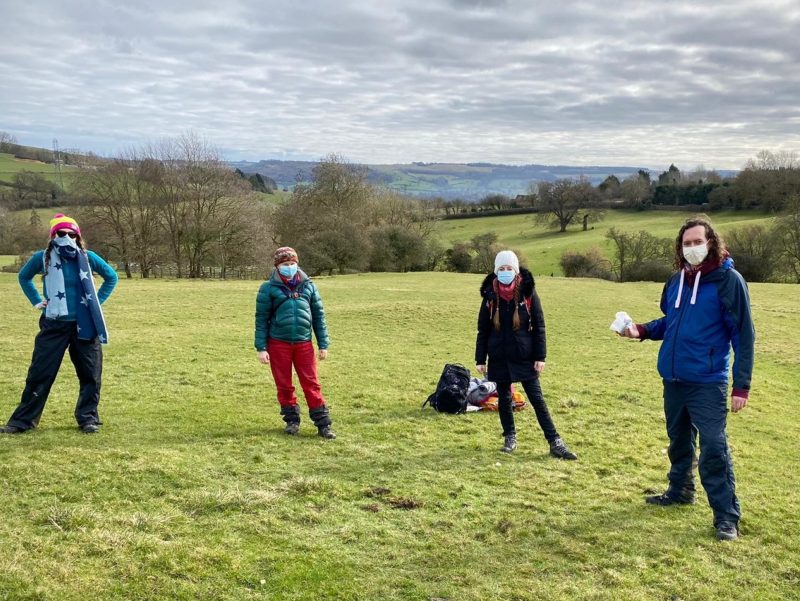
Scientists in the U.K. announced March 9, 2021, that they’ve made a rare recovery of a meteorite that fell to Earth just a few days ago. The discovery stemmed from the widespread sighting – on February 28 – of a fireball, a very bright meteor or shooting star, that lit up the sky as seen from across the U.K. and northern Europe. Now astronomers and meteorite experts have located the space rock that created that display. They found pieces of the rock in Winchcombe, Gloucestershire. It’s likely to become known as the Winchcombe meteorite, according to meteorite experts at the University of Manchester Natural History Museum.
The meteorite is of a type called a carbonaceous chondrite. Only a small percentage of meteorites come from this category, and they are the most primitive and pristine materials of our solar system, having orbited for billions of years before entering our atmosphere. This sort of meteorite has also been known to contain organic material and amino acids, that is, the ingredients for life.
Those are some of the reasons scientists are so excited about finding this meteorite so soon after it fell, before earthly wind and water had a chance to begin affecting it. They said they retrieved the meteorite so quickly after its fall that it’s comparable to asteroid samples returned from space missions, both in quality and quantity.
They’re also excited because this rare type of meteorite has never been recovered in the U.K. before. It’s the first recovered meteorite in the U.K. in the past 30 years
Specialized cameras – part of the U.K. Fireball Alliance (UKFAll) – were able to recreate the February 28 fireball’s flight path, allowing scientists to determine exactly where in the solar system the space rock came from, and also to predict where it fell.
The group ultimately recovered about 10.5 ounces (300 grams) of the meteorite. Part of it landed on a driveway in the town of Winchcombe, described as “a small market town of early medieval origin, in the Cotswold hills of Gloucestershire, England.” Other pieces of the exceptional meteorite were also recovered in the area.
The original space rock is estimated to have been traveling at nearly 9 miles per second (14 km/s) before hitting the Earth’s atmosphere, experts said.

Ashley King, of the Department of Earth Sciences at the Natural History Museum in Manchester, was among the first on the scene when the meteorite was discovered on March 3, 2021, and has been advising on the handling and care of the meteorite since. He said in a statement:
Nearly all meteorites come to us from asteroids, the leftover building blocks of the solar system that can tell us how planets like the Earth formed. The opportunity to be one of the first people to see and study a meteorite that was recovered almost immediately after falling is a dream come true!
The meteor blazed across UK skies on the night of February 28, 2021, delighting those lucky enough to spot it. Sky watchers spotted the meteor shortly before 10 p.m. It was visible for about 7 seconds and was captured on doorbell and security cameras in Manchester, Cardiff, Honiton, Bath, Midsomer Norton and Milton Keynes. Video via The Guardian.
Katherine Joy, a researcher at the University of Manchester, said:
This is a hugely exciting scientific event as it is the first time in 30 years that a meteorite sample has fallen and been recovered in the U.K. Normally we have to send spacecraft to collect bits of other worlds, but this time one has fallen right into our laps! We look forward to using our laboratories in Manchester and working with our colleagues to investigate how the newly recovered U.K. meteorite fall can provide insights into how planets in the early solar system were formed.
Richard Greenwood, a planetary scientist at the Open University, was the first scientist to identify and advise on the meteorite. He said:
I was in shock when I saw it and immediately knew it was a rare meteorite and a totally unique event. It’s emotional being the first one to confirm to the people standing in front of you that the thud they heard on their driveway overnight is in fact the real thing.
These scientists said that, once they had confirmed the meteorite was genuine, they made plans for it to be moved safely to the University of Manchester Natural History Museum in Manchester, England. Their statement said that, at the museum:
… it will be properly cared for until it begins an official process of classification to establish its validity and scientific significance.

A team of specialist scientists from across the U.K. have been successfully searching the rest of the predicted fall area for more fragments, including colleagues from the University of Glasgow, the University of Manchester, the Open University, the University of Plymouth, and Imperial College London. The University of Manchester also provided this information:
There are approximately 65,000 known meteorites on Earth. Only 1,206 have been witnessed to fall and of these, only 51 are carbonaceous chondrites. This is the first known carbonaceous chondrite to have been found in the U.K., and the first meteorite recovered in the U.K. in 30 years. The last meteorite that was discovered in the U.K. was the Glatton meteorite that landed in a residential garden in 1991.
A victory for U.K. citizen science, the fireball was seen by thousands of eyewitnesses across the U.K. and northern Europe, many of whom reported it to the U.K. Meteor Observation Network, and was captured on many fireball cameras and home surveillance cameras when it fell to Earth at 21:54 on Sunday, February 28.
Meteorites are incredibly old. Their age of about 4,567 million years is much older than any rock from the Earth. Almost all these space rocks have been blasted off asteroids, and travel for many thousands of years through space before being captured, usually by the sun, but occasionally by Earth. They travel through the atmosphere, sometimes – like the one that fell in Gloucestershire – producing a bright fireball before landing on Earth. Over 1,000 meteorites the size of a football are believed to fall to Earth every year; however, it is very rare for any of them to be seen to fall and recovered.
Carbonaceous chondrites, like the one just discovered, are made of a mixture of minerals and organic compounds, including amino acids. They are the most primitive and pristine materials of the solar system and can provide unique information on where water and the building blocks of life were formed and what planets are made from – some of the biggest questions asked by the scientific community.
Sara Russell of the Natural History Museum advised on the care of the meteorite once it was located. She said:
The Japanese space mission Hayabusa2 returned around 4.5 grams [.16 ounces] of fragments from asteroid Ryugu to Earth in December last year, and at the Museum we are helping to characterize this material. The Winchcombe meteorite fall is very timely as the rock is similar to Ryugu in many ways, and we can use the meteorite to rehearse for mission analyses.
The team believes that more fragments may yet be discovered. They said:
This fragile meteorite may be found as black stones, or as piles of tiny rock or even dust. If you are local to the area and find something that could be meteorite, please be sure to take a photo of it and record its location, before collecting the sample using a gloved hand or in aluminium foil and contacting the Natural History Museum.
However, please respect local lockdown Covid-19 regulations.
Bottom line: U.K. scientists and meteor experts announced March 9, 2021, that they’ve recovered pieces of a rare carbonaceous chondrite meteorite, just days after it entered Earth’s atmosphere and streaked across the sky, visible from the U.K. and northern Europe. They found pieces of the rock in Winchcombe, Gloucestershire, and say it’s likely to become known as the Winchcombe meteorite.











